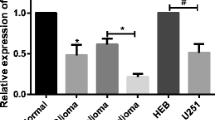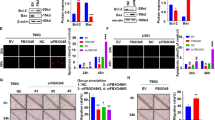Abstract
Glioma is characterized by high invasion, migration and proliferation abilities. However, the molecular mechanism that triggers the development and recurrence of this tumor is also elusive. This study aims to investigate the biological function and molecular mechanism of microRNA218 in glioma. Human glioma samples were obtained and employed to investigate the correlation between microRNA218 and glioma pathological grading. Glioma cell viability was detected by the cell-counting kit-8 (CCK-8) cell counting assay. Transwell assay and wound-healing assay were employed to examine the migration and invasion of the glioma cells. The mRNA transcription and protein expression of glioma-associated oncogene homolog 1 (GLI1) were analyzed by quantitative RT-PCR and Western blot analysis, respectively. Southwestern blot assay was utilized to explore the possible interaction site of GLI1 and microRNA218. The results indicated that microRNA218 is significantly down-regulated in glioma samples and negatively correlated with the pathological grading. The cell viability was significantly decreased, and migration and invasion were significantly inhibited in microRNA218 treated cells, compared with un-treated cells. GLI1 was discovered acting as a functional downstream target of microRNA218, by which microRNA218 inhibited glioma cell migration and invasion. Southwestern blot result showed that microRNA218 targeted directly the N terminus of GLI1 molecular, and repressed the GLI1 expression in U87MG cells. In conclusion, microRNA218 could reduce the invasion and migration, and inhibit proliferation of glioma cells by suppressing the expression of GLI1 protein at the interacting with the N terminus.





Similar content being viewed by others
References
An LW, Liu YJ, Wu AH, Guan YF. MicroRNA-124 inhibits migration and invasion by down-regulating ROCK1 in glioma. PLoS One. 2013;8(7):e69478.
Tu YY, Gao XC, Li G. MicroRNA-218 inhibits glioma invasion, migration, proliferation and cancer stem-like cell self-renewal by targeting the polycomb group gene Bmi1. Cancer Res. 2013. doi:10.1158/0008-5472.CAN-13-0358.
Ohgaki H, Kleihues P. Population-based studies on incidence, survival rates, and genetic alterations in astrocytic and oligodendroglial gliomas. J Neuropathol Exp Neurol. 2005;64(6):479–89.
Louis DN, Ohgaki H, Wiestler QD, Gavenee WK, Burger PC, Jouvet A, et al. The 2007 WHO classification of tumors of the central nervous system. Acta Neuropathol. 2007;114(2):97–109.
Koga Y, Yasunaga M, Moriya Y, Akasu T, Fujita S, Yamamoto S, et al. Exosome can prevent RNase from degrading microRNA in fece. J Gastrointest Oncol. 2011;2(4):215–22.
Li YY, Wang Y, Yu L, Sun CY, Cheng DG, Yu SZ, et al. miR-146b-5p inhibits glioma migration and invasion by targeting MMP16. Cancer Lett. 2013;339(2):260–9.
Lu S, Mukkada VA, Mangray S, Cleveland K, Shillingford N, Schorl C, et al. MicroRNA profiling in mucosal biopsies of eosinophilic esophagitis patients pre and post-treatment with steroids with relationship with mRNA targets. PLoS One. 2012;7(7):e40676.
Friedman RC, Farh KK, Burge CB, Bartel DP. Most mammalian mRNA are conserved targets of microRNAs. Genome Res. 2009;19(1):92–105.
Li QJ, Zhou L, Yang F, Wang GX, Zheng H, Wang DS, et al. MicroRNA-10b promotes migration and invasion through CADM1 in human hepatocellular carcinoma cells. Tumor Biol. 2012;33(5):1455–65.
Sana J, Hajduch M, Michalek J, Vyzula R, Slaby O. MicroRNA and glioblastoma: roles in core signaling pathways and potential clinical implications. J Cell Mol Med. 2011;15(8):1636–44.
Garcia AI, Buisson M, Bertrand P, Rimokh R, Rouleau E, Lopez BS, et al. Down-regulation of BRCA1 expression by miR-146a and miR-146b-5p in triple negative sporadic breast cancers. EMBO Mol Med. 2011;3(5):279–90.
Lee YS, Dutta A. MicroRNAs in cancer. Annu Rev Pathol. 2009;4(1):199–227.
Skalsky RL, Cullen BR. Reduced expression of brain-enriched microRNA in glioblastomas permits targeted regulation of a cell death gene. PLoS One. 2011;6(9):e24248.
Song L, Huang Q, Chen K, Liu L, Lin C, Dai T, et al. miR-218 inhibits the invasive ability of glioma cells by direct downregulation of IKK-beta. Biochem Biophys Res Commun. 2010;402(1):135–40.
Li CH, To KF, Tong JHM, Xiao ZG, Xia T, Lai PBS, et al. Enhancer of zeste homolog 2 silences microRNA-218 in human pancreatic ductal adenocarcinoma cells by inducing formation of heterochromatin. Gastroenterology. 2013;144(5):1086–97.
Yamasaki T, Seki N, Yoshino H, Itesako T, Hidaka H, Yamada Y, et al. MicroRNA-218 inhibits cell migration and invasion in renal cell carcinoma through targeting Caveolin-2 involved in focal adhesion pathway. J Urol. 2013;190(3):1059–68.
Jansson MD, Lund AH. MicroRNA and cancer. Mol Oncol. 2012;6(6):590–610.
Lees CW, Zacharias WJ, Tremelling M, Noble CL, Nimmo ER, Tenesa A, et al. Analysis of germline GLI1 variation implicates hedgehog signaling in the regulation of intestinal inflammatory pathways. PLoS Med. 2008;5(12):e239.
Hwang HW, Mendell JT. MicroRNAs in cell proliferation, cell death, and tumorigenesis. Br J Cancer. 2006;94(6):776–80.
Zhang Y, Dutta A, Abounader R. The role of microRNAs in glioma initiation and progression. Front Biosci (Landmark Ed). 2012;17(1):700–12.
Malzkorn B, Wolter M, Liesenberg F, Grzendowski M, Stuhler K, Meyer HE, et al. Identification and functional characterization of microRNAs involved in the malignant progression of gliomas. Brain Pathol. 2010;20(3):539–50.
Gaur A, Jewell DA, Liang Y, Ridzon D, Moore JH, Chen C, et al. Characterization of microRNA expression levels and their biological correlates in human cancer cell lines. Cancer Res. 2007;67(6):2456–68.
Setty M, Helmy K, Khan AA, Silber J, Arvey A, Neezen F, et al. Inferring transcription and microRNA-mediated regulatory programs in gliomastoma. Mol Syst Biol. 2012;8(1):605.
Kasper M, Regl G, Frischauf AM, Aberger F. GLI transcription factors: mediators of oncogenic Hedgehog signaling. Eur J Cancer. 2006;42(4):437–45.
Nisson M, Unden AB, Krause D, Malmqwist U, Raza K, Zaphiropoulos PG, et al. Induction of basal cell carcinomas and trichoepitheliomas in mice overexpressing GLI-1. Proc Natl Acad Sci U S A. 2000;97(7):3438–43.
Clement V, Sanchez P, de Tribolet N, Radovanovic I, Ruizi AA. HEDGEHOG-GLI1 signaling regulates human growth, cancer stem cell self-renewal, and tumorigenicity. Curr Biol. 2007;17(2):165–72.
Ruizi Altaba A, Mas C, Stecca B. The GLI code: an information nexus regulating cell fate, stemness and cancer. Trends Cell Biol. 2007;17(9):438–47.
Agarwal NK, Qu C, Kunkalla K, Liu Y, Vega F. Transcriptional regulation of serine/threonine protein kinase (AKT) genes by glioma-associated oncogene homolog 1. J Biol Chem. 2013;288(21):15390–401.
Shimakawa T, Tostar U, Lauth M, Palaniswamy R, Kasper M, Toftgard R, et al. Novel human Glioma-associated oncogene 1 (GLI1) splice variants reveal distinct mechanism in the terminal teransduction of the hedgehog signal. J Biol Chem. 2008;283(21):14345–54.
Chen J, McKay RM, Parada LF. Malignant glioma: lessons from genomics mouse models, and stem cells. Cell. 2012;149(1):36–47.
Conflicts of interest
None
Author information
Authors and Affiliations
Corresponding author
Additional information
B. Peng and D. Li contributed equally to this study.
Rights and permissions
About this article
Cite this article
Peng, B., Li, D., Qin, M. et al. MicroRNA218 inhibits glioma migration and invasion via inhibiting glioma-associated oncogene homolog 1 expression at N terminus. Tumor Biol. 35, 3831–3837 (2014). https://doi.org/10.1007/s13277-013-1507-3
Received:
Accepted:
Published:
Issue Date:
DOI: https://doi.org/10.1007/s13277-013-1507-3




